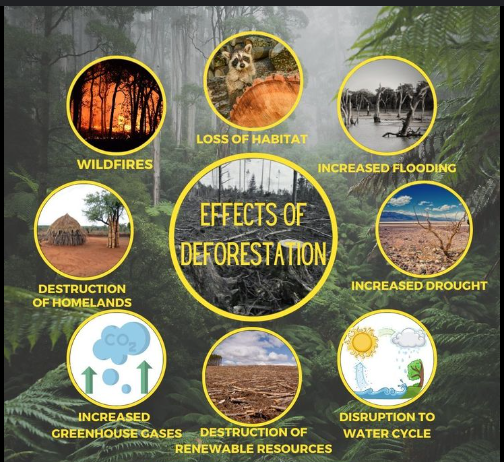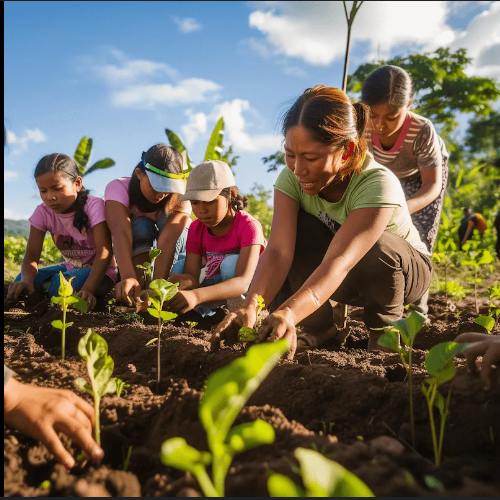Deforestation, the large-scale removal of forests, is one of the most pressing environmental issues of our time. It impacts the planet on multiple levels, affecting climate, biodiversity, and local communities. Understanding the far-reaching consequences of deforestation, as well as exploring viable solutions, is essential for addressing this complex problem.
Global Consequences of Deforestation
- Climate Change: Forests play a crucial role in regulating the Earth’s climate. They act as carbon sinks, absorbing carbon dioxide (CO2) from the atmosphere and helping to mitigate climate change. When trees are cut down or burned, this stored carbon is released back into the atmosphere, significantly contributing to global warming. The loss of forests exacerbates the greenhouse effect, leading to rising temperatures and more severe weather patterns.
- Loss of Biodiversity: Forests are home to more than half of the world’s terrestrial species, including countless plants, animals, and microorganisms. Deforestation leads to habitat destruction, which can drive species to extinction. As forests disappear, the complex web of life they support unravels, reducing biodiversity and destabilizing ecosystems. The loss of species can have cascading effects, disrupting ecological balances and reducing the resilience of ecosystems to environmental changes.
- Disruption of Water Cycles: Forests play a key role in the global water cycle. Trees absorb and release water through a process called transpiration, which helps to regulate local and global precipitation patterns. Deforestation disrupts these water cycles, leading to reduced rainfall, more severe droughts, and changes in river flow. This can affect agriculture, water supply, and overall ecosystem health.
- Soil Degradation: Tree roots help to anchor the soil and prevent erosion. Without this natural protection, deforested areas become more vulnerable to soil erosion and degradation. This not only reduces the fertility of the land but can also lead to sedimentation in rivers and lakes, which impacts water quality and aquatic life.
- Impact on Indigenous Communities: Many indigenous communities around the world rely on forests for their livelihoods, culture, and sustenance. Deforestation can displace these communities, disrupt their traditional ways of life, and lead to conflicts over land and resources. The loss of forests often means the loss of the cultural and spiritual values that are closely tied to the land.

Read More :Climate Change: Understanding the Causes, Effects, and Solutions
Local Solutions to Deforestation
Addressing deforestation requires a multi-faceted approach that involves both global and local strategies. While international agreements and policies play a role, local solutions are crucial for effective and sustainable change.
- Reforestation and Afforestation: Planting trees and restoring degraded forests are key strategies to combat deforestation. Reforestation involves replanting trees in areas where forests have been cut down, while afforestation involves planting trees in areas that were not previously forested. These efforts help to restore biodiversity, improve soil health, and capture carbon dioxide.
- Sustainable Forestry Practices: Implementing sustainable forestry practices can help to balance economic needs with environmental protection. This includes techniques such as selective logging, where only certain trees are harvested, and maintaining forest cover. Certification programs like the Forest Stewardship Council (FSC) provide guidelines and standards for sustainable forestry, helping to ensure that forest resources are used responsibly.
- Agroforestry: Integrating trees into agricultural systems, known as agroforestry, can provide multiple benefits. Trees can improve soil fertility, enhance biodiversity, and provide shade and shelter for crops. This approach can reduce the pressure on forests by allowing for productive land use without completely clearing forested areas.
- Community-Based Conservation: Empowering local communities to take an active role in forest conservation can be highly effective. Community-based conservation projects involve local people in decision-making and management of forest resources. By providing alternative livelihoods, education, and support, these initiatives can reduce the reliance on destructive practices and promote sustainable use of forest resources.
- Legal and Policy Measures: Strong legal frameworks and policies are essential for combating deforestation. This includes enforcing laws against illegal logging, implementing land use planning, and providing incentives for conservation. Governments can also support policies that promote sustainable land management and protect critical forest areas.
- Education and Awareness: Raising awareness about the importance of forests and the impacts of deforestation is crucial for driving change. Educational programs can help people understand the benefits of forests and the actions they can take to support conservation efforts. This includes promoting responsible consumption patterns, such as reducing paper use and choosing sustainably sourced products.
- Supporting Indigenous Rights: Recognizing and supporting the land rights of indigenous communities can help to protect forests. Indigenous peoples often have deep knowledge of forest ecosystems and sustainable practices. By respecting their rights and involving them in conservation efforts, we can leverage their expertise and protect forests more effectively.
- Technology and Innovation: Advances in technology can aid in monitoring and managing forests. Satellite imagery, drones, and geographic information systems (GIS) can provide valuable data on forest cover and changes over time. These tools help to track deforestation, enforce regulations, and plan conservation strategies.

Conclusion
Deforestation is a complex issue with profound global consequences, from climate change and loss of biodiversity to disruptions in water cycles and impacts on local communities. Addressing this challenge requires a combination of global initiatives and local solutions. By focusing on reforestation, sustainable practices, community involvement, legal measures, and education, we can work towards preserving our forests and ensuring a healthier planet for future generations. The collective effort of individuals, communities, governments, and organizations is essential in reversing the effects of deforestation and promoting a sustainable future.

Leave a comment